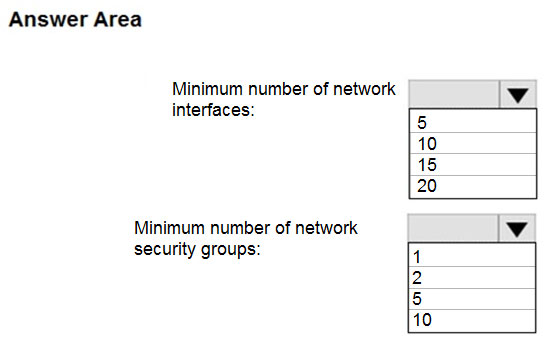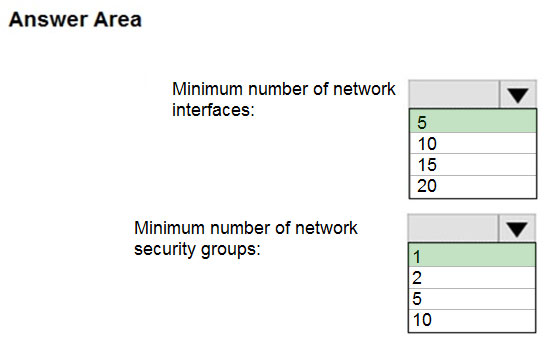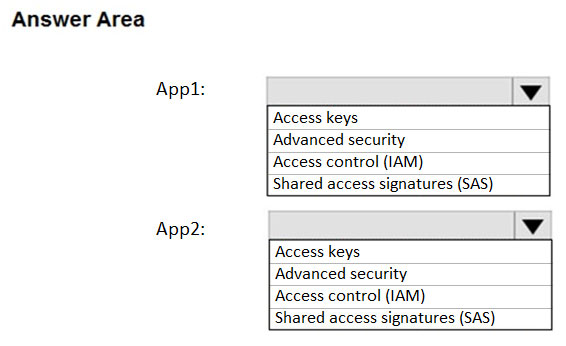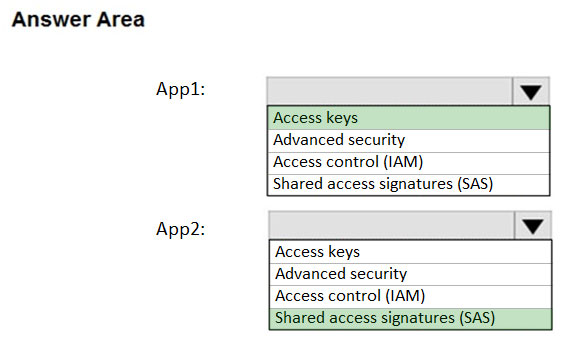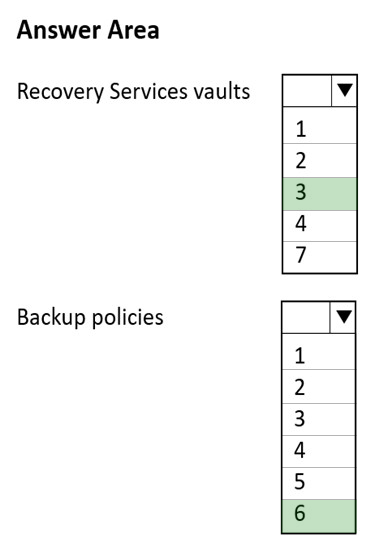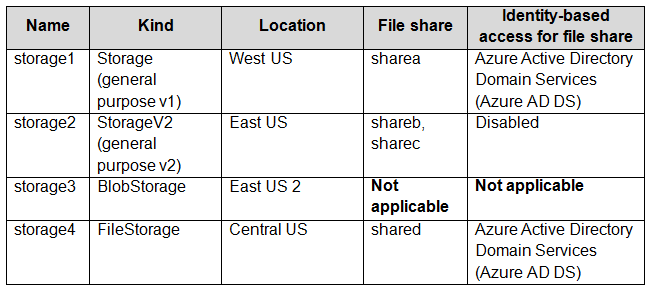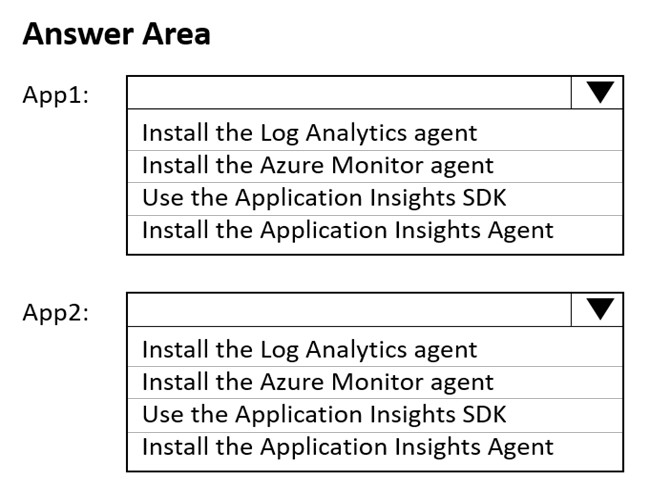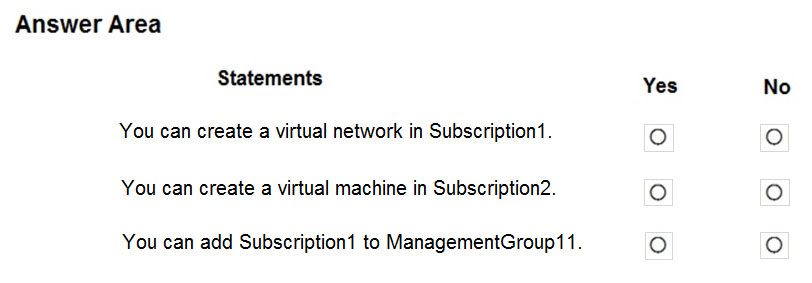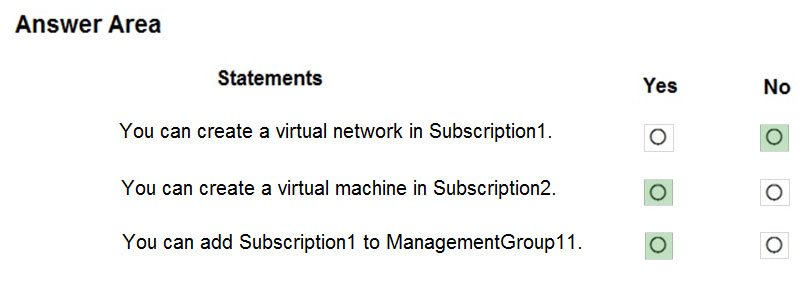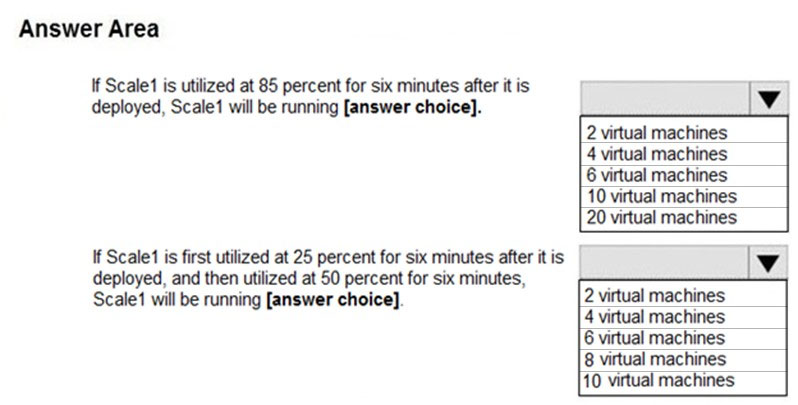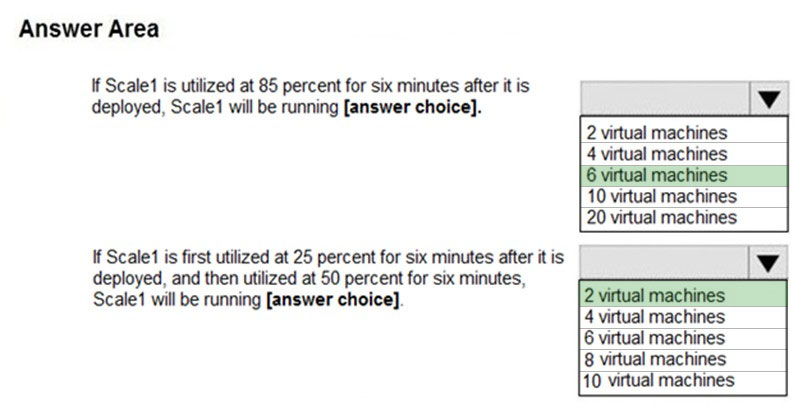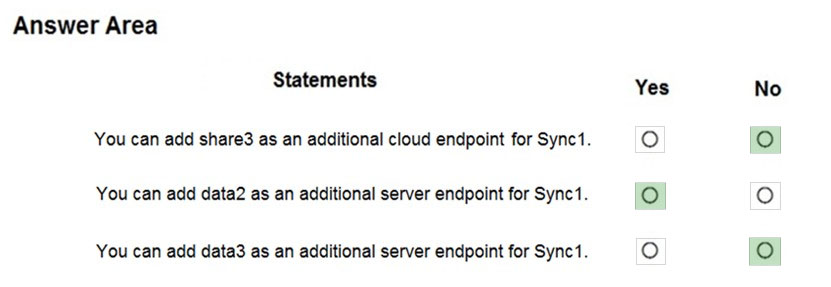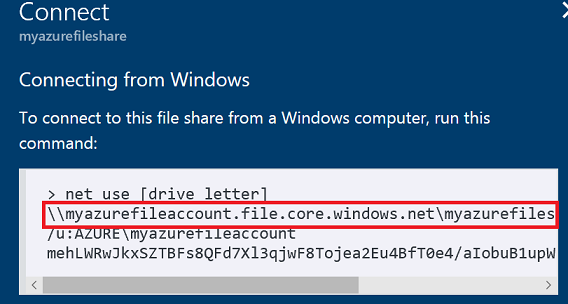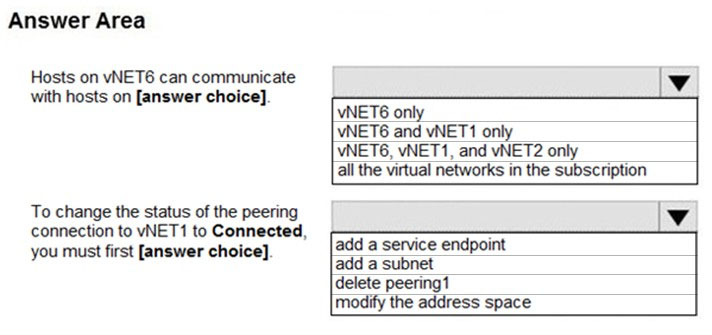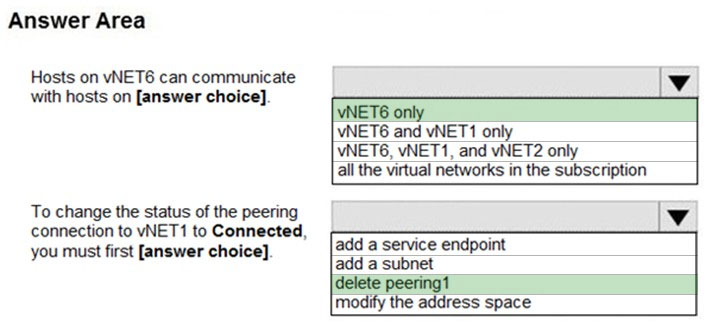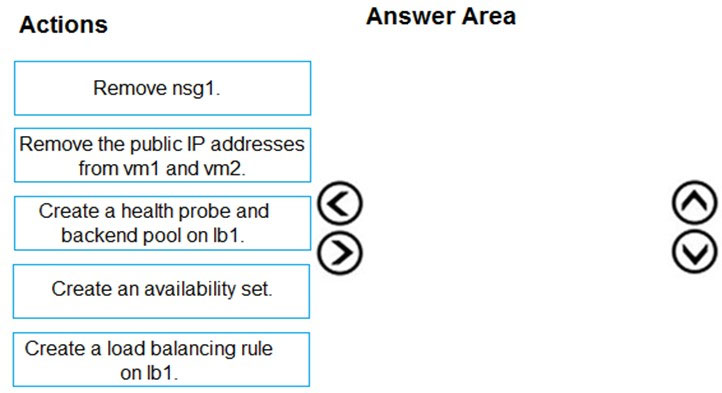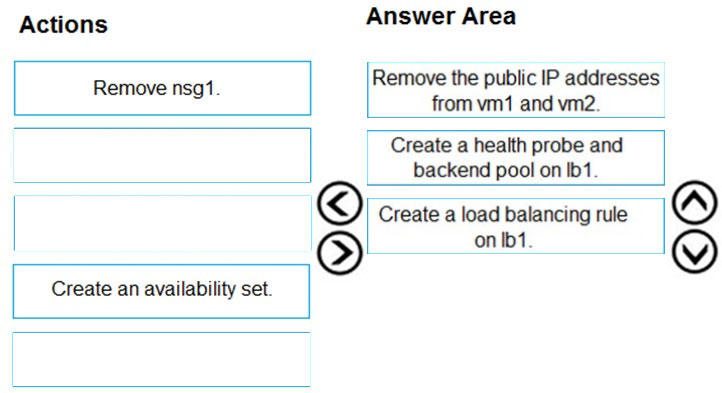AZ-104 Practice Questions Free – 50 Exam-Style Questions to Sharpen Your Skills
Are you preparing for the AZ-104 certification exam? Kickstart your success with our AZ-104 Practice Questions Free – a carefully selected set of 50 real exam-style questions to help you test your knowledge and identify areas for improvement.
Practicing with AZ-104 practice questions free gives you a powerful edge by allowing you to:
- Understand the exam structure and question formats
- Discover your strong and weak areas
- Build the confidence you need for test day success
Below, you will find 50 free AZ-104 practice questions designed to match the real exam in both difficulty and topic coverage. They’re ideal for self-assessment or final review. You can click on each Question to explore the details.
HOTSPOT - You plan to deploy five virtual machines to a virtual network subnet. Each virtual machine will have a public IP address and a private IP address. Each virtual machine requires the same inbound and outbound security rules. What is the minimum number of network interfaces and network security groups that you require? To answer, select the appropriate options in the answer area. NOTE: Each correct selection is worth one point. Hot Area:
You have an Azure subscription that contains the resources shown in the following table.You create a public IP address named IP1. Which two resources can you associate to IP1? Each correct answer presents a complete solution. NOTE: Each correct selection is worth one point.
A. VM1
B. LB1
C. NIC1
D. VPN1
E. VNet1
Note: This question is part of a series of questions that present the same scenario. Each question in the series contains a unique solution that might meet the stated goals. Some question sets might have more than one correct solution, while others might not have a correct solution. After you answer a question in this section, you will NOT be able to return to it. As a result, these questions will not appear in the review screen. You have an Azure Directory (Azure AD) tenant named Adatum and an Azure Subscription named Subscription1. Adatum contains a group named Developers. Subscription1 contains a resource group named Dev. You need to provide the Developers group with the ability to create Azure logic apps in the Dev resource group. Solution: On Subscription1, you assign the DevTest Labs User role to the Developers group. Does this meet the goal?
A. Yes
B. No
Note: This question is part of a series of questions that present the same scenario. Each question in the series contains a unique solution that might meet the stated goals. Some question sets might have more than one correct solution, while others might not have a correct solution. After you answer a question in this section, you will NOT be able to return to it. As a result, these questions will not appear in the review screen. You manage a virtual network named VNet1 that is hosted in the West US Azure region. VNet1 hosts two virtual machines named VM1 and VM2 that run Windows Server. You need to inspect all the network traffic from VM1 to VM2 for a period of three hours. Solution: From Azure Network Watcher, you create a connection monitor. Does this meet the goal?
A. Yes
B. No
You plan to create an Azure Storage account named storage1 that will contain a file share named share1. You need to ensure that share1 can support SMB Multichannel. The solution must minimize costs. How should you configure storage?
A. Premium performance with locally-redundant storage (LRS)
B. Standard performance with zone-redundant storage (ZRS)
C. Premium performance with geo-redundant storage (GRS)
D. Standard performance with locally-redundant storage (LRS)
You have five Azure virtual machines that run Windows Server 2016. The virtual machines are configured as web servers. You have an Azure load balancer named LB1 that provides load balancing services for the virtual machines. You need to ensure that visitors are serviced by the same web server for each request. What should you configure?
A. Floating IP (direct server return) to Enabled
B. Idle Time-out (minutes) to 20
C. a health probe
D. Session persistence to Client IP
Note: This question is part of a series of questions that present the same scenario. Each question in the series contains a unique solution that might meet the stated goals. Some question sets might have more than one correct solution, while others might not have a correct solution. After you answer a question in this section, you will NOT be able to return to it. As a result, these questions will not appear in the review screen. You need to ensure that an Azure Active Directory (Azure AD) user named Admin1 is assigned the required role to enable Traffic Analytics for an Azure subscription. Solution: You assign the Traffic Manager Contributor role at the subscription level to Admin1. Does this meet the goal?
A. Yes
B. No
Note: This question is part of a series of questions that present the same scenario. Each question in the series contains a unique solution that might meet the stated goals. Some question sets might have more than one correct solution, while others might not have a correct solution. After you answer a question in this section, you will NOT be able to return to it. As a result, these questions will not appear in the review screen. You have an Azure subscription named Subscription1. Subscription1 contains a resource group named RG1. RG1 contains resources that were deployed by using templates. You need to view the date and time when the resources were created in RG1. Solution: From the RG1 blade, you click Deployments. Does this meet the goal?
A. Yes
B. No
HOTSPOT - You have an Azure subscription that contains a resource group named RG1. You plan to use an Azure Resource Manager (ARM) template named template1 to deploy resources. The solution must meet the following requirements: • Deploy new resources to RG1. • Remove all the existing resources from RG1 before deploying the new resources. How should you complete the command? To answer, select the appropriate options in the answer area. NOTE: Each correct selection is worth one point.
HOTSPOT - You have an Azure AD user named User1 and a read-access geo-redundant storage (RA-GRS) account named contoso2023. You need to meet the following requirements: • User1 must be able to write blob data to contoso2023. • The contoso2023 account must fail over to its secondary endpoint. Which two settings should you configure? To answer, select the appropriate settings in the answer area. NOTE: Each correct selection is worth one point.
HOTSPOT - You have an Azure Storage account named storage1. You have an Azure App Service app named App1 and an app named App2 that runs in an Azure container instance. Each app uses a managed identity. You need to ensure that App1 and App2 can read blobs from storage1. The solution must meet the following requirements: ✑ Minimize the number of secrets used. ✑ Ensure that App2 can only read from storage1 for the next 30 days. What should you configure in storage1 for each app? To answer, select the appropriate options in the answer area. NOTE: Each correct selection is worth one point. Hot Area:
Overview - Litware, Inc. is a consulting company that has a main office in Montreal and two branch offices in Seattle and New York. The Montreal office has 2,000 employees. The Seattle office has 1,000 employees. The New York office has 200 employees. All the resources used by Litware are hosted on-premises. Litware creates a new Azure subscription. The Azure Active Directory (Azure AD) tenant uses a domain named litware.onmicrosoft.com. The tenant uses the Premium P1 pricing tier. Existing Environment - The network contains an Active Directory forest named litware.com. All domain controllers are configured as DNS servers and host the litware.com DNS zone. Litware has finance, human resources, sales, research, and information technology departments. Each department has an organizational unit (OU) that contains all the accounts of that respective department. All the user accounts have the department attribute set to their respective department. New users are added frequently. Litware.com contains a user named User1. All the offices connect by using private connections. Litware has data centers in the Montreal and Seattle offices. Each office has a firewall that can be configured as a VPN device. All infrastructure servers are virtualized. The virtualization environment contains the servers in the following table.Litware uses two web applications named App1 and App2. Each instance on each web application requires 1 GB of memory. The Azure subscription contains the resources in the following table.
The network security team implements several network security groups (NSGs) Requirements - Planned Changes - Litware plans to implement the following changes: Deploy Azure ExpressRoute to the Montreal office. Migrate the virtual machines hosted on Server1 and Server2 to Azure. Synchronize on-premises Active Directory to Azure Active Directory (Azure AD). Migrate App1 and App2 to two Azure web apps named WebApp1 and WebApp2. Technical Requirements - Litware must meet the following technical requirements: Ensure that WebApp1 can adjust the number of instances automatically based on the load and can scale up to five instances.
Ensure that VM3 can establish outbound connections over TCP port 8080 to the applications servers in the Montreal office. Ensure that routing information is exchanged automatically between Azure and the routers in the Montreal office. Enable Azure Multi-Factor Authentication (MFA) for the users in the finance department only. Ensure that webapp2.azurewebsites.net can be accessed by using the name app2.litware.com. Connect the New York office to VNet1 over the Internet by using an encrypted connection. Create a workflow to send an email message when the settings of VM4 are modified. Create a custom Azure role named Role1 that is based on the Reader role. Minimize costs whenever possible. You need to recommend a solution to automate the configuration for the finance department users. The solution must meet the technical requirements. What should you include in the recommendation?
A. Azure AD B2C
B. dynamic groups and conditional access policies
C. Azure AD Identity Protection
D. an Azure logic app and the Microsoft Identity Management (MIM) client
You have an Azure subscription that contains the resources shown in the following table.You need to assign Workspace1 a role to allow read, write, and delete operations for the data stored in the containers of storage1. Which role should you assign?
A. Storage Account Contributor
B. Contributor
C. Storage Blob Data Contributor
D. Reader and Data Access
You have an Azure subscription that contains two virtual machines named VM1 and VM2. You create an Azure load balancer. You plan to create a load balancing rule that will load balance HTTPS traffic between VM1 and VM2. Which two additional load balancer resources should you create before you can create the load balancing rule? Each correct answer presents part of the solution. NOTE: Each correct selection is worth one point.
A. a frontend IP address
B. an inbound NAT rule
C. a virtual network
D. a backend pool
E. a health probe
HOTSPOT - You have an Azure AD tenant that contains a user named External User. External User authenticates to the tenant by using external195@gmail.com . You need to ensure that External User authenticates to the tenant by using contractor@gmail.com . Which two settings should you configure from the Overview blade? To answer, select the appropriate settings in the answer area. NOTE: Each correct answer is worth one point.
HOTSPOT - Your company purchases a new Azure subscription. You create a file named Deploy.json as shown in the following exhibit.You connect to the subscription and run the following cmdlet. New-AzDeployment -Location westus -TemplateFile “deploy.json” For each of the following statements, select Yes if the statement is true. Otherwise, select No. NOTE: Each correct selection is worth one point.
Overview - General Overview - Contoso, Ltd. is a consulting company that has a main office in Montreal and branch offices in Seattle and New York. Environment - Existing Environment - Contoso has an Azure subscription named Sub1 that is linked to an Azure Active Directory (Azure AD) tenant. The network contains an on-premises Active Directory domain that syncs to the Azure AD tenant. The Azure AD tenant contains the users shown in the following table.Sub1 contains two resource groups named RG1 and RG2 and the virtual networks shown in the following table.
User1 manages the resources in RG1. User4 manages the resources in RG2. Sub1 contains virtual machines that run Windows Server 2019 as shown in the following table
No network security groups (NSGs) are associated to the network interfaces or the subnets. Sub1 contains the storage accounts shown in the following table.
Requirements - Planned Changes - Contoso plans to implement the following changes: Create a blob container named container1 and a file share named share1 that will use the Cool storage tier. Create a storage account named storage5 and configure storage replication for the Blob service. Create an NSG named NSG1 that will have the custom inbound security rules shown in the following table.
Associate NSG1 to the network interface of VM1. Create an NSG named NSG2 that will have the custom outbound security rules shown in the following table.

Associate NSG2 to VNET1/Subnet2. Technical Requirements - Contoso must meet the following technical requirements: Create container1 and share1. Use the principle of least privilege. Create an Azure AD security group named Group4. Back up the Azure file shares and virtual machines by using Azure Backup. Trigger an alert if VM1 or VM2 has less than 20 GB of free space on volume C. Enable User1 to create Azure policy definitions and User2 to assign Azure policies to RG1. Create an internal Basic Azure Load Balancer named LB1 and connect the load balancer to VNET1/Subnet1 Enable flow logging for IP traffic from VM5 and retain the flow logs for a period of eight months. Whenever possible, grant Group4 Azure role-based access control (Azure RBAC) read-only permissions to the Azure file shares. HOTSPOT - You need to configure Azure Backup to back up the file shares and virtual machines. What is the minimum number of Recovery Services vaults and backup policies you should create? To answer, select the appropriate options in the answer area. NOTE: Each correct selection is worth one point. Hot Area:
You have an Azure subscription named Subscription1. You have 5 TB of data that you need to transfer to Subscription1. You plan to use an Azure Import/Export job. What can you use as the destination of the imported data?
A. Azure Blob Storage
B. Azure Data Lake Store
C. Azure SQL Database
D. a virtual machine
You deploy an Azure Kubernetes Service (AKS) cluster named Cluster1 that uses the IP addresses shown in the following table.You need to provide internet users with access to the applications that run in Cluster1. Which IP address should you include in the DNS record for Cluster1?
A. 131.107.2.1
B. 10.0.10.11
C. 172.17.7.1
D. 192.168.10.2
DRAG DROP - You have an Azure subscription that contains a resource group named RG1. You plan to create an Azure Resource Manager (ARM) template to deploy a new virtual machine named VM1. VM1 must support the capture of performance data. You need to specify resource dependencies for the ARM template. In which order should you deploy the resources? To answer, move all resources from the list of resources to the answer area and arrange them in the correct order.
HOTSPOT - You have an Azure subscription that contains an Azure Active Directory (Azure AD) tenant named contoso.com. The tenant is synced to the on-premises Active Directory domain. The domain contains the users shown in the following table.You enable self-service password reset (SSPR) for all users and configure SSPR to have the following authentication methods: ✑ Number of methods required to reset: 2 ✑ Methods available to users: Mobile phone, Security questions ✑ Number of questions required to register: 3 ✑ Number of questions required to reset: 3 You select the following security questions: ✑ What is your favorite food? ✑ In what city was your first job? ✑ What was the name of your first pet? For each of the following statements, select Yes if the statement is true. Otherwise, select No. NOTE: Each correct selection is worth one point. Hot Area:
You have an Azure subscription that contains a virtual machine named VM1. You plan to deploy an Azure Monitor alert rule that will trigger an alert when CPU usage on VM1 exceeds 80 percent. You need to ensure that the alert rule sends an email message to two users named User1 and User2. What should you create for Azure Monitor?
A. an action group
B. a mail-enabled security group
C. a distribution group
D. a Microsoft 365 group
You have an Azure subscription that contains a storage account named storage1. The storage1 account contains a container named container1. You need to configure access to container1. The solution must meet the following requirements: • Only allow read access. • Allow both HTTP and HTTPS protocols. • Apply access permissions to all the content in the container. What should you use?
A. an access policy
B. a shared access signature (SAS)
C. Azure Content Delivery Network (CDN)
D. access keys
You have the Azure virtual machines shown in the following table:You have a Recovery Services vault that protects VM1 and VM2. You need to protect VM3 and VM4 by using Recovery Services. What should you do first?
A. Create a new Recovery Services vault
B. Create a storage account
C. Configure the extensions for VM3 and VM4
D. Create a new backup policy
HOTSPOT - You have the web apps shown in the following table.You need to monitor the performance and usage of the apps by using Azure Application Insights. The solution must minimize modifications to the application code. What should you do on each app? To answer, select the appropriate options in the answer area. NOTE: Each correct selection is worth one point. Hot Area:
Note: This question is part of a series of questions that present the same scenario. Each question in the series contains a unique solution that might meet the stated goals. Some question sets might have more than one correct solution, while others might not have a correct solution. After you answer a question in this section, you will NOT be able to return to it. As a result, these questions will not appear in the review screen. You have an Azure subscription that contains the following resources: ✑ A virtual network that has a subnet named Subnet1 ✑ Two network security groups (NSGs) named NSG-VM1 and NSG-Subnet1 ✑ A virtual machine named VM1 that has the required Windows Server configurations to allow Remote Desktop connections NSG-Subnet1 has the default inbound security rules only. NSG-VM1 has the default inbound security rules and the following custom inbound security rule: ✑ Priority: 100 ✑ Source: Any ✑ Source port range: * ✑ Destination: * ✑ Destination port range: 3389 ✑ Protocol: UDP ✑ Action: Allow VM1 has a public IP address and is connected to Subnet1. NSG-VM1 is associated to the network interface of VM1. NSG-Subnet1 is associated to Subnet1. You need to be able to establish Remote Desktop connections from the internet to VM1. Solution: You add an inbound security rule to NSG-Subnet1 and NSG-VM1 that allows connections from the internet source to the VirtualNetwork destination for port range 3389 and uses the TCP protocol. Does this meet the goal?
A. Yes
B. No
HOTSPOT - You have the Azure management groups shown in the following table:You add Azure subscriptions to the management groups as shown in the following table:
You create the Azure policies shown in the following table:
For each of the following statements, select Yes if the statement is true. Otherwise, select No. NOTE: Each correct selection is worth one point. Hot Area:
You have an Azure subscription named Subscription1 that contains virtual network named VNet1. VNet1 is in a resource group named RG1. A user named User1 has the following roles for Subscription1: • Reader • Security Admin • Security Reader You need to ensure that User1 can assign the Reader role for VNet1 to other users. What should you do?
A. Assign User1 the Contributor role for VNet1.
B. Assign User1 the Network Contributor role for VNet1.
C. Assign User1 the User Access Administrator role for VNet1.
D. Remove User1 from the Security Reader and Reader roles for Subscription1. Assign User1 the Contributor role for Subscription1.
Note: This question is part of a series of questions that present the same scenario. Each question in the series contains a unique solution that might meet the stated goals. Some question sets might have more than one correct solution, while others might not have a correct solution. After you answer a question in this section, you will NOT be able to return to it. As a result, these questions will not appear in the review screen. You have an Azure subscription that contains the following users in an Azure Active Directory tenant named contoso.onmicrosoft.com:User1 creates a new Azure Active Directory tenant named external.contoso.onmicrosoft.com. You need to create new user accounts in external.contoso.onmicrosoft.com. Solution: You instruct User3 to create the user accounts. Does that meet the goal?
A. Yes
B. No
You have an Azure web app named App1. App1 has the deployment slots shown in the following table:In webapp1-test, you test several changes to App1. You back up App1. You swap webapp1-test for webapp1-prod and discover that App1 is experiencing performance issues. You need to revert to the previous version of App1 as quickly as possible. What should you do?
A. Redeploy App1
B. Swap the slots
C. Clone App1
D. Restore the backup of App1
Note: The question is included in a number of questions that depicts the identical set-up. However, every question has a distinctive result. Establish if the solution satisfies the requirements. Your company's Azure subscription includes two Azure networks named VirtualNetworkA and VirtualNetworkB. VirtualNetworkA includes a VPN gateway that is configured to make use of static routing. Also, a site-to-site VPN connection exists between your company's on- premises network and VirtualNetworkA. You have configured a point-to-site VPN connection to VirtualNetworkA from a workstation running Windows 10. After configuring virtual network peering between VirtualNetworkA and VirtualNetworkB, you confirm that you are able to access VirtualNetworkB from the company's on-premises network. However, you find that you cannot establish a connection to VirtualNetworkB from the Windows 10 workstation. You have to make sure that a connection to VirtualNetworkB can be established from the Windows 10 workstation. Solution: You download and re-install the VPN client configuration package on the Windows 10 workstation. Does the solution meet the goal?
A. Yes
B. No
HOTSPOT - You create a virtual machine scale set named Scale1. Scale1 is configured as shown in the following exhibit.Use the drop-down menus to select the answer choice that completes each statement based on the information presented in the graphic. NOTE: Each correct selection is worth one point. Hot Area:
You have an Azure subscription that contains an Azure Storage account. You plan to create an Azure container instance named container1 that will use a Docker image named Image1. Image1 contains a Microsoft SQL Server instance that requires persistent storage. You need to configure a storage service for Container1. What should you use?
A. Azure Files
B. Azure Blob storage
C. Azure Queue storage
D. Azure Table storage
Note: This question is part of a series of questions that present the same scenario. Each question in the series contains a unique solution that might meet the stated goals. Some question sets might have more than one correct solution, while others might not have a correct solution. After you answer a question in this section, you will NOT be able to return to it. As a result, these questions will not appear in the review screen. You have an Azure subscription named Subscription1. Subscription1 contains a resource group named RG1. RG1 contains resources that were deployed by using templates. You need to view the date and time when the resources were created in RG1. Solution: From the Subscriptions blade, you select the subscription, and then click Resource providers. Does this meet the goal?
A. Yes
B. No
You have a virtual network named VNet1 as shown in the exhibit. (Click the Exhibit tab.)No devices are connected to VNet1. You plan to peer VNet1 to another virtual network named VNet2. VNet2 has an address space of 10.2.0.0/16. You need to create the peering. What should you do first?
A. Modify the address space of VNet1.
B. Add a gateway subnet to VNet1.
C. Create a subnet on VNet1 and VNet2.
D. Configure a service endpoint on VNet2.
You have an Azure subscription that contains an Azure virtual machine named VM1. VM1 runs a financial reporting app named App1 that does not support multiple active instances. At the end of each month, CPU usage for VM1 peaks when App1 runs. You need to create a scheduled runbook to increase the processor performance of VM1 at the end of each month. What task should you include in the runbook?
A. Add the Azure Performance Diagnostics agent to VM1.
B. Modify the VM size property of VM1.
C. Add VM1 to a scale set.
D. Increase the vCPU quota for the subscription.
E. Add a Desired State Configuration (DSC) extension to VM1.
Note: This question is part of a series of questions that present the same scenario. Each question in the series contains a unique solution that might meet the stated goals. Some questions sets might have more than one correct solution, while others might not have a correct solution. After you answer a question in this section, you will NOT be able to return to it. As a result, these questions will not appear in the review screen. You deploy an Azure Kubernetes Service (AKS) cluster named AKS1. You need to deploy a YAML file to AKS1. Solution: From Azure Cloud Shell, you run az aks. Does this meet the goal?
A. Yes
B. No
You have an Azure subscription named Subscription1 that contains virtual network named VNet1. VNet1 is in a resource group named RG1. A user named User1 has the following roles for Subscription1: • Reader • Security Admin • Security Reader You need to ensure that User1 can assign the Reader role for VNet1 to other users. What should you do?
A. Remove User1 from the Security Reader and Reader roles for Subscription1. Assign User1 the Contributor role for Subscription1.
B. Assign User1 the Contributor role for VNet1.
C. Assign User1 the Owner role for VNet1.
D. Assign User1 the Network Contributor role for RG1.
You have an Azure subscription that contains a storage account named storage1. You plan to use conditions when assigning role-based access control (RBAC) roles to storage1. Which storage1 services support conditions when assigning roles?
A. containers only
B. file shares only
C. tables only
D. queues only
E. containers and queues only
F. files shares and tables only
DRAG DROP - You have an Azure subscription that contains two on-premises locations named site1 and site2. You need to connect site1 and site2 by using an Azure Virtual WAN. Which four actions should you perform in sequence? To answer, move the appropriate actions from the list of actions to the answer area and arrange them in the correct order. Select and Place:
Note: The question is included in a number of questions that depicts the identical set-up. However, every question has a distinctive result. Establish if the solution satisfies the requirements. Your company has an Azure Active Directory (Azure AD) tenant named weyland.com that is configured for hybrid coexistence with the on-premises Active Directory domain. You have a server named DirSync1 that is configured as a DirSync server. You create a new user account in the on-premise Active Directory. You now need to replicate the user information to Azure AD immediately. Solution: You use Active Directory Sites and Services to force replication of the Global Catalog on a domain controller. Does the solution meet the goal?
A. Yes
B. No
HOTSPOT - You have an Azure subscription that contains the file shares shown in the following table.You have the on-premises file shares shown in the following table.
You create an Azure file sync group named Sync1 and perform the following actions: ✑ Add share1 as the cloud endpoint for Sync1. ✑ Add data1 as a server endpoint for Sync1. ✑ Register Server1 and Server2 to Sync1. For each of the following statements, select Yes if the statement is true. Otherwise, select No. NOTE: Each correct selection is worth one point. Hot Area:
DRAG DROP - You have an Azure subscription named Subscription1. You create an Azure Storage account named contosostorage, and then you create a file share named data. Which UNC path should you include in a script that references files from the data file share? To answer, drag the appropriate values to the correct targets. Each value may be used once, more than once or not at all. You may need to drag the split bar between panes or scroll to view content. NOTE: Each correct selection is worth one point. Select and Place:
HOTSPOT - You have peering configured as shown in the following exhibit.Use the drop-down menus to select the answer choice that completes each statement based on the information presented in the graphic. NOTE: Each correct selection is worth one point. Hot Area:
You have an Azure subscription that contains a resource group named TestRG. You use TestRG to validate an Azure deployment. TestRG contains the following resources:You need to delete TestRG. What should you do first?
A. Modify the backup configurations of VM1 and modify the resource lock type of VNET1
B. Remove the resource lock from VNET1 and delete all data in Vault1
C. Turn off VM1 and remove the resource lock from VNET1
D. Turn off VM1 and delete all data in Vault1
You create an Azure Storage account named contosostorage. You plan to create a file share named data. Users need to map a drive to the data file share from home computers that run Windows 10. Which outbound port should you open between the home computers and the data file share?
A. 80
B. 443
C. 445
D. 3389
DRAG DROP - You have an Azure subscription that contains the resources shown in the following table.You need to load balance HTTPS connections to vm1 and vm2 by using lb1. Which three actions should you perform in sequence? To answer, move the appropriate actions from the list of actions to the answer area and arrange them in the correct order. Select and Place:
HOTSPOT - You have an Azure Storage account named storage1 that contains a blob container. The blob container has a default access tier of Hot. Storage1 contains a container named conainer1. You create lifecycle management rules in storage1 as shown in the following table.You perform the actions shown in the following table.
For each of the following statements, select Yes if the statement is true. Otherwise, select No. NOTE: Each correct selection is worth one point. Hot Area:
HOTSPOT - You need to configure a new Azure App Service app named WebApp1. The solution must meet the following requirements: • WebApp1 must be able to verify a custom domain name of app.contoso.com. • WebApp1 must be able to automatically scale up to eight instances. • Costs and administrative effort must be minimized. Which pricing plan should you choose, and which type of record should you use to verify the domain? To answer, select the appropriate options in the answer area. NOTE: Each correct answer is worth one point.
You have an Azure subscription named Subscription1. You have 5 TB of data that you need to transfer to Subscription1. You plan to use an Azure Import/Export job. What can you use as the destination of the imported data?
A. a virtual machine
B. an Azure Cosmos DB database
C. Azure File Storage
D. the Azure File Sync Storage Sync Service
Free Access Full AZ-104 Practice Questions Free
Want more hands-on practice? Click here to access the full bank of AZ-104 practice questions free and reinforce your understanding of all exam objectives.
We update our question sets regularly, so check back often for new and relevant content.
Good luck with your AZ-104 certification journey!


